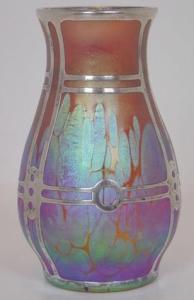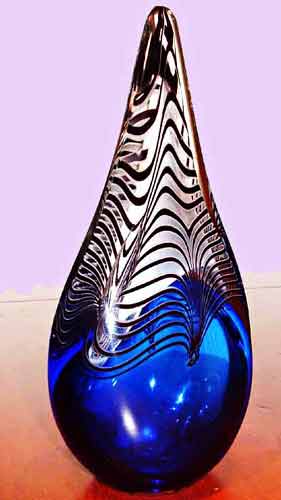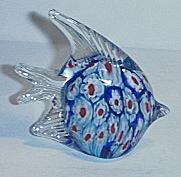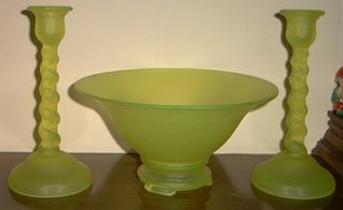
Guide to Collecting Glassware, Part 3
Written by Rosemary Trietsch
TIPS FOR
BUYING, SELLING AND COLLECTING GLASS
Whether you're buying glass as a collector or a dealer, remember these three words: Condition, condition, and condition. Nothing turns off a potential customer faster than a chip, crack, scratch or repair. Likewise, the value of your collection is directly related to the condition of your glass. Of course, there are a few exceptions to this rule. Should the piece be one of a kind, a special order or exhibition piece, or an example of a rare technique, less than perfect may be accepted. However, you should expect to pay a small percentage - 10 to 15% - of the price it would sell for if it were in mint condition. Common items rarely sell in damaged condition, as there are an abundance of perfect pieces readily available.

Silver
Overlay
Often times, beginning collectors make the mistake of buying
"everything in sight" in their collecting interests early on. Only later do they discover their tastes have changed and
begin to look for more elusive pieces. Less
is more! The best way to create a
serious collection is to buy the best examples your collecting budget can afford
- even if this means you have to stretch that budget a little. Remember: Quality
vs. Quantity. Instead of 10 low-end items, buy one or two better examples.
They'll hold their value better and chances are good that you won't see another
one like it anytime soon.
This same principle holds true if you are collecting glass tableware – such as Depression glass or crystal stemware. Buy rare or hard to find items when you see them as they appreciate in price much more quickly than common items. Most beginning collectors balk at the idea of paying high prices for uncommon items and will pass up a cookie jar at $100 in favor of 5 dinner plates at $20. Unfortunately, two years down the road when they decide to add the jar to their collection, there are fewer around for sale and so the price has risen to $165 while the dinners sell for $22.

Contemporary Glass
How
do you know which items are more common? Buy the books. Reference books are
available that focus on specific glass manufactures.
Read up on which shapes are uncommon, or which colors were produced in
the smallest quantities. Also watch
for information on one of a kind or sample (experimental) items. Remember: one of the first glass purchases you make should be
a book. Take your books with you to the shows so you don't miss any bargains.
Another
good idea is to make a list of pieces you would like to acquire. While you're at
the shows, give your list to dealers that sell similar items and ask them to
contact you should they find anything on your want list.
It may take a while, but in time your phone will start ringing.
Finally,
the Internet has paved the way for collectors to expand their collections, as
you are no longer limited to the shows and shops in your area.
By taking advantage of regional markets, you can often locate hard to
find items - usually for less than you'd pay locally. What might be easy to find
on the East Coast might be hard to find on the West Coast.
Make sure to use the search engines such as Auction Rover to do a daily
search for the key pieces you are searching for. You never know what might turn
up.
Selling off the items that you no longer want in your collection is a great way to ‘support your habit’, and the Internet is one of your best selling tools. When selling items online, you open yourself to a larger client base than ever before and can use regional markets to your advantage. While the local collectors can keep your shop busy, some of the slower selling items can be seen as "treasures" by collectors from other locales.

Millefiori
glass
When listing your items for sale online, ask yourself this question; What would I want to know about this piece in order to buy it? Pretend you are buying it, but have not been given a photo of it. What would you need to know in order to decide if this was something for you or not? The most important factors are 1) What does it look like? A picture is worth a thousand words. People want to see the goods before purchasing. If you don't have a photo, you are likely not to sell it. 2) What is the condition? Well, the photo looks great, but does the backside have scratches? Are there internal flaws? Scratches? Tell them, and be critical. The things you might find to be minor, others might not – remember: condition, condition, and condition. 3) When was it made? Is the piece you are selling a newer reproduction or the real thing? People want to know. Tell them all you know about the item. 4) What color is it? Might seem obvious from the image, however not everyone sees things the same. If its Yellow, tell them yellow. They might see orange! 5) If the item arrives and is not what you represented it as, will you take it back? A return privilege is the best way to develop repeat customers. They want to know if they buy from you and the item is damaged or not as described, you will stand behind your product and return their money. 6) Lastly, do you have more like it? If you do have more of a similar item, tell them. It could turn a single sale into a package sale!

Satin
Vaseline Glass
LINKS
TO HELPFUL GLASS SITES
Searching
the Internet for glass resources can be tiresome.
With hundreds of thousands of sites, which ones will help you find the
information you need? Below is a list of some of our favorite "glass
spots" on the Internet. If you
have any you think should be added to this list, please email us at
justglassauction@aol.com
Glass
Restoration
- Aunt Mary's vase...you've seen it proudly displayed on the mantle since you
were a kid. Today the maid nicked
it when removing the dust. What do
you do? Search this site for the
Antique Glass Repair and Restoration expert near you.
Glass
Marks/Identification
-The flea markets have opened and you see a garage sale on every block.
You stop and purchase several stunning pieces of glassware.
Now you want to know more about your prized purchases. Aha! You see a
mark! looks like a ...duck's head? How
will you ever figure out who made it? For the most comprehensive list of glass
marks on the Internet visit Heartland-Discoveries at
Glass
Collections/Museums
- Your heart goes pitter-patter each time you pick up your favorite glass book.
Where can you experience all these wonderful examples of glass up close? Why a glass museum of course!
Visit this page for some of the best glass collections on display in a
museum near you.
Glass
Collectors Message Board
- What is it? What's it worth? Are they reproduced?
I collect.... Join an online message board such as those sponsored by Just
Glass Auctions to get answers to all of your questions and meet others with
similar collecting interests. http://www.justglass.com
- click on Message Board
Glass
Club Listings
- Glass Collectors Clubs can be a wonderful thing. Learn more about your
collection, find out about upcoming shows and events, and meet others in your
neighborhood who have similar glass collecting interests by joining a National
Glass Club. Click here for a
listing of organization and information on joining.
Glass
Books/Reference
- What's the most important thing to own when collecting glass?
Reference books! One can never have too many.
Reproductions
- The market is filled with them - from the low end to the high end.
A great way to learn more about what is on the market, and how to spot it
visit http://www.mindspring.com/~reyne/repro.html